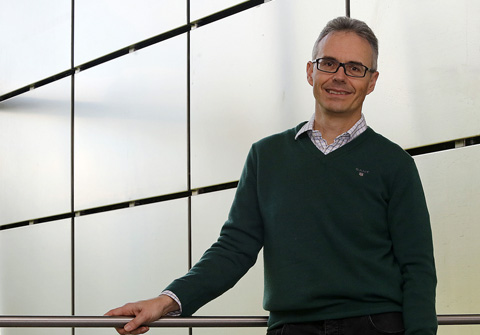A theoretical study based on computational simulations conducted by the UPV/EHU's Nano-bio Spectroscopy Research Group in collaboration with the Japanese research centre AIST, has shown that the intensity of ultraviolet light that is made to pass through a graphene nano-ribbon is modulated with a terahertz frequency. So we are seeing the opening up of a new field of research into obtaining terahertz radiation that has a whole host of applications. The research has been published in the prestigious journal Nanoscale.
The properties of light can be controlled by means of nanostructures
A study led by the UPV/EHU-University of the Basque Country professor Ángel Rubio has simulated a new device to generate terahertz radiation using carbon nanostructures
First publication date: 04/03/2016

The UPV/EHU's Nano-bio Spectroscopy Research Group led by Ángel Rubio, a UPV/EHU professor in the Department of Materials Physics and director of the Max Planck Institute for Structure and Dynamics of Matter in Hamburg, has simulated the converting of ultraviolet light into radiation in the terahertz range by making it pass through a graphene nano-ribbon, and has put forward a new compact device designed to generate radiation of this type based on the phenomenon discovered. The research, conducted in collaboration with the research group led by Yoshiyuki Miyamoto of the National Institute of Advanced Industrial Science and Technology (AIST) of Japan, has appeared in the prestigious journal Nanoscale, published by the Royal Society of Chemistry (United Kingdom).
Low-frequency terahertz radiation has a broad range of applications, such as the characterisation of molecules, materials, tissues, etc. However, right now it is difficult to manufacture small, efficient, low-cost devices to produce terahertz radiation. This phenomenon "extends the range of applicability of radiation of this type to many other spheres in which it was not being used," explained Ángel Rubio, "owing to the fact that one would have to resort to much bigger radiation sources".
The starting point of a new field of research
To carry out this simulation, they used graphene nano-ribbons: strips cut out of sheets of graphene. In the research they concluded that UV light that exerts an effect on the nano-ribbon emits a totally different radiation (terahertz) perpendicular to the incident light. This phenomenon "opens up the possibility of generating structures that will allow the frequency range to be changed using different nanostructures," explained Prof Rubio. "A new field of research is being opened up".
Now that the existence of the phenomenon has been demonstrated, "it would be necessary to see if the same thing can be done with a different type of light source," explained Ángel Rubio. In the research they used a high-intensity laser pointer so that the simulation would be correct, but it should be possible to use "more accessible light sources", he specified. What is more, another step to be taken in this field would be "to use a set of nanostructures instead of a single one to produce an actual device."
The UPV/EHU group has worked on the proposal of the idea and its implementation in code that allows a simulation to be made on the computer, while the Japanese research centre AIST has been responsible for the numerical calculations. The researchers have used novel simulation techniques of first principles, methods in which the predictive capacity is very high: the behaviour of a material is predicted without using external parameters. "The simulation techniques have reached a point," concluded Rubio, "where systems that are later shown to actually behave in the same way experimentally can be predicted".
Additional information
The Nano-bio Spectroscopy Group is led by Ángel Rubio. The group's activity focusses on the theoretical research and modelling of electronic and structural properties of condensed matter as well as the development of new theoretical tools and computer codes to explore the electronic response of solids and nanostructures when handling external electromagnetic fields.
Ángel Rubio is a UPV/EHU professor, a member of the Department of Materials Sciences, and director of the Theory Department of the Max Planck Institute for Structure and Dynamics of Matter. He has over 300 scientific publications and over 22,000 mentions in the scientific literature. His research activity is internationally recognised and he has also received numerous distinctions and awards.
Bibliographic reference
- Optical field terahertz amplitude modulation by graphene nanoribbons
- Nanoscale, 2015,7, 19012-19017
- DOI: 10.1039/C5NR05889A

